| 1 | Bangkok’s main venomous snake |
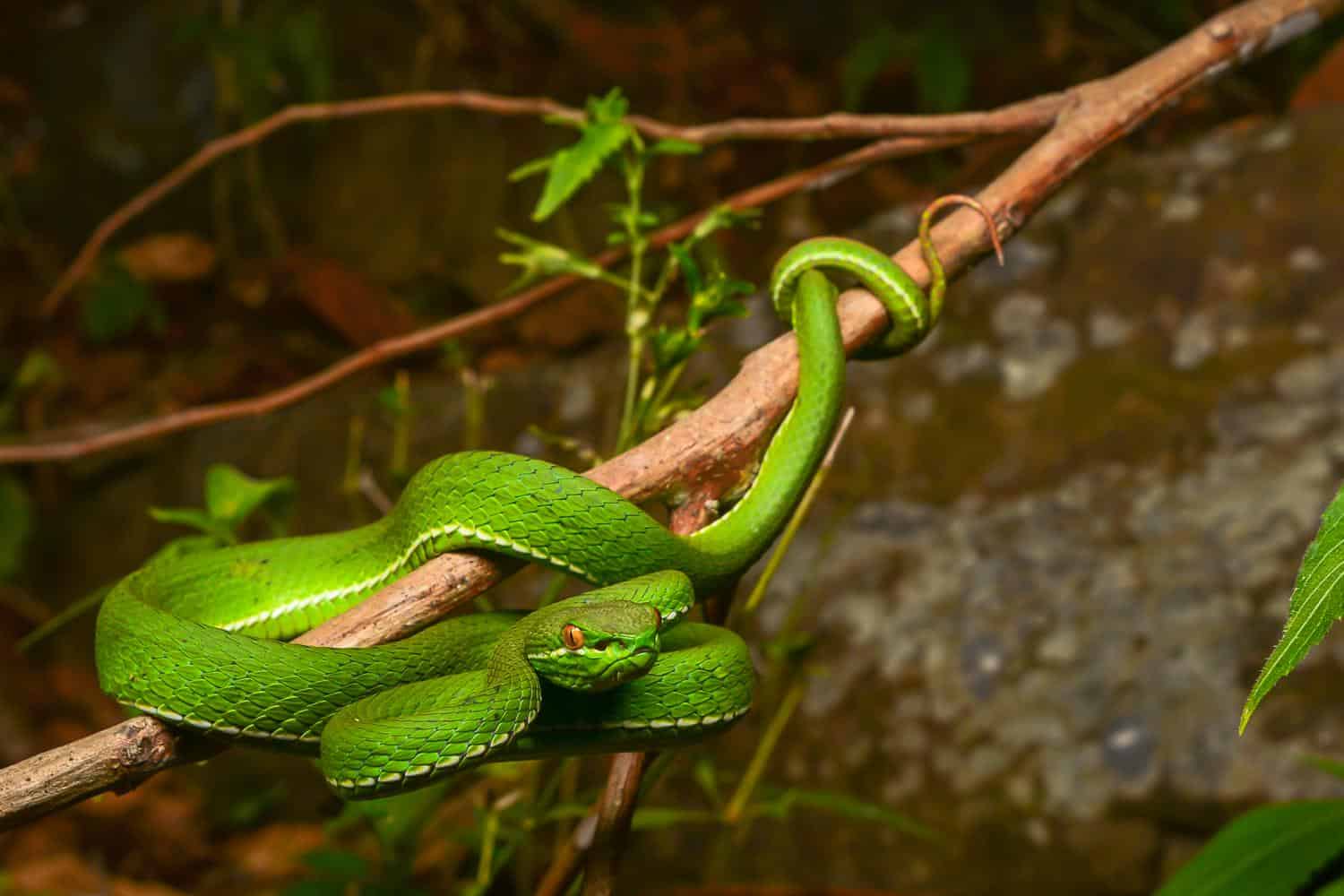
The green pitvipers (Trimeresurus) are a huge snake family found in southeast Asia, which has at least 40 confirmed members. All are dangerously venomous, and to an untrained eye they can look extremely similar. Trimeresurus pitvipers are neon green, with vertical pupils and a hungry, crafty expression. Thailand alone hosts 15 of these terrors, and one is overwhelmingly the most common: the white-lipped pitviper (Trimeresurus albolabris).
This venomous snake is often found resting on bushes and low branches, blending into the moist greenery, waiting patiently for prey to pass. White-lipped pitvipers are extremely widespread in Asia, ranging from Hong Kong to Vietnam to Myanmar. They’re one of just two green pitvipers found in inner city Bangkok, alongside the large-eyed pitviper (Trimeresurus macrops).
This is an aggressive face familiar to all Thai people, except in the extreme south. White-lipped pitvipers rarely kill, but can cause catastrophic local damage such as necrotic skin and blistering. Most importantly, this cunning viper bites freely, without worrying about the consequences, from the shrubs and bushes it loves to rest on.
| 2 | Dominates all bite statistics |
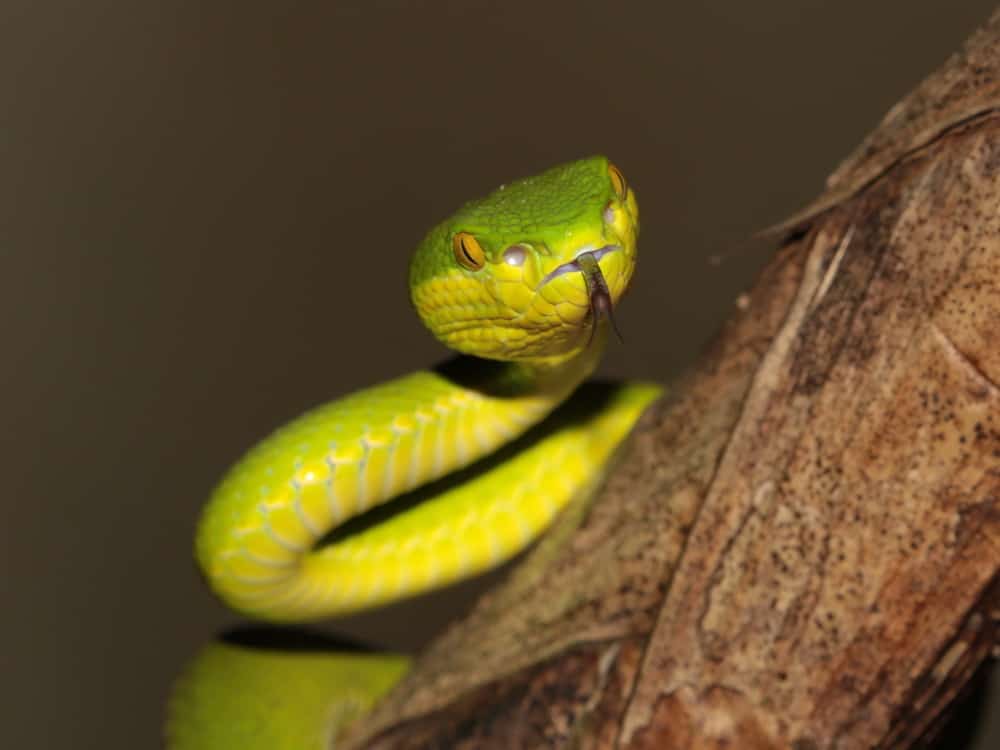
The snakebite stats for this common pitviper are overwhelming. In the Bangkok metropolitan area, they’re estimated to cause 95% of snakebites, together with their friend/relative Trimeresurus macrops. Across Thailand, the figure has been estimated at 30-40%, with the monocled cobra also making up a large share. A study from 1997 declared that bites were becoming more common, by 73.5%.
In Hong Kong, the white-lipped pit viper is overwhelmingly the bitiest snake. A survey of snakebites from Prince Of Wales hospital found that of 242 snakebites, the species dominated with ease. The saving grace was that only 1 person died, in a study lasting 4 years.
In 2009, Hong Kong suffered 139 snakebites. 95% came from the white-lipped pitviper, even though other venomous snakes such as red-necked keelbacks and Chinese cobras live there. This snake is able to bite, but also willing to bite. Unlike other snakes, which vanish when natural habitat is pushed back, the white-lipped pitviper adapts well to urban environments like Hong Kong.
| 3 | Shreds skin, spares the brain |
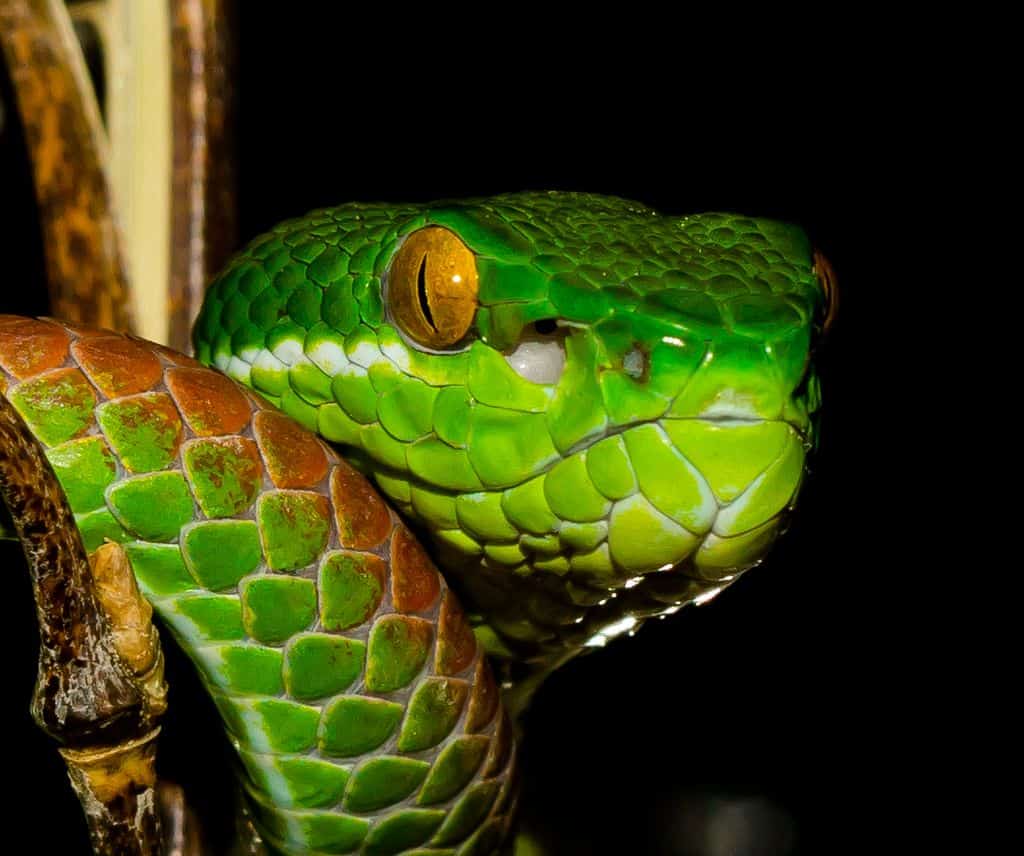
Unlike the nearby monocled cobra, white-lipped pitvipers have virtually no neurotoxic powers. Lung failure or trouble speaking won’t trouble you with this snake. However, the bite causes agonising local symptoms, with blistering, swelling and pain.
White-lipped pitvipers have a more severe venom than their Thai neighbour Trimeresurus macrops. An unlucky second tier of victims progress to necrosis, when tissue and tendons start to die and slough off. A study on 80 Thai bites found that 9 became necrotic, and 2 of those resulted in amputation.
The main systemic symptom is spontaneous bleeding, which can happen from the gums or gastrointestinal tract. Nausea, vomiting, diarrhoea are also possibilities. You might also experience a “haemorrhagic blister”: it looks like a normal blister, but is filled with blood instead of clear fluid. A weirder symptom in the archives involved a guy who tried to lick his bite wound clean. His prize was a severely swollen tongue and lips.
The final tier is death. While extremely rare, two elderly patients are recorded as having died at Chulalongkorn hospital, Thailand, both from intercranial haemorrhage.
| 4 | Comfortable in urban gardens |
In the countryside, white-lipped pitvipers are found in forests and the margins of agricultural fields. However, it’s rare for them to appear in the centre of fields, lurking between rows of wheat.
Instead of thick rainforest, Trimeresurus albolabris only needs small amounts of vegetation to survive; hence why they’re so common in urban areas. White-lipped pitvipers are most at home in gardens, including within Bangkok. Thai people might walk to their backfence with an armful of hedge clippings, to dump in a compost pile, only to be bitten by a white-lipped pitviper lurking on a branch. This is an ambush snake which rests on branches for hours, but unlike golden tree snakes, they prefer bushy branches just 0.5-1 metre above ground.
This study mentioned a Nepali who was bitten on the premises of a herbal company. In Bangkok, you can even find this snake in overgrown alleyways between buildings, with weeds and grasses pushing through cracks in the pavement. If you’re walking through Bangkok with your shoulders hunched and you hear a rustle in the bushes, you may have just met Trimeresurus albolabris.
| 5 | Any Thai bush could contain them |
In a study on 24 white-lipped pitviper bites in Thailand, 50% of victims were bitten while cutting or collecting plants, flowers, grasses and tree branches. 54% were bitten on the upper arm, while the rest were bitten on the lower arm. This viper stays still all day, yet has an aggressive personality, and bites people walking past without a second thought – hence why it causes 95% of Bangkok bites. Even artificial lighting such as streetlamps doesn’t bother them. White-lipped pitvipers sometimes shake their tail inside vegetation to make a fake rattling sound.
Some branch dwellers like the emerald tree boa look as though they’re sleeping, keeping their head in a comfortable nest of coils. But trimeresurus albolabris is different – it stays in a constant frozen strike pose, with its lower body coiled, and its head poked out in preparation to lunge. They stay like this for hours, waiting patiently for a frog to pass their bush. Before they pounce on prey, the white-lipped pitviper will undulate its tail, moving it slowly from side to side. This is a clear sign that the hunting frenzy is about to kick off.
| 6 | Eats frogs, fears rats |
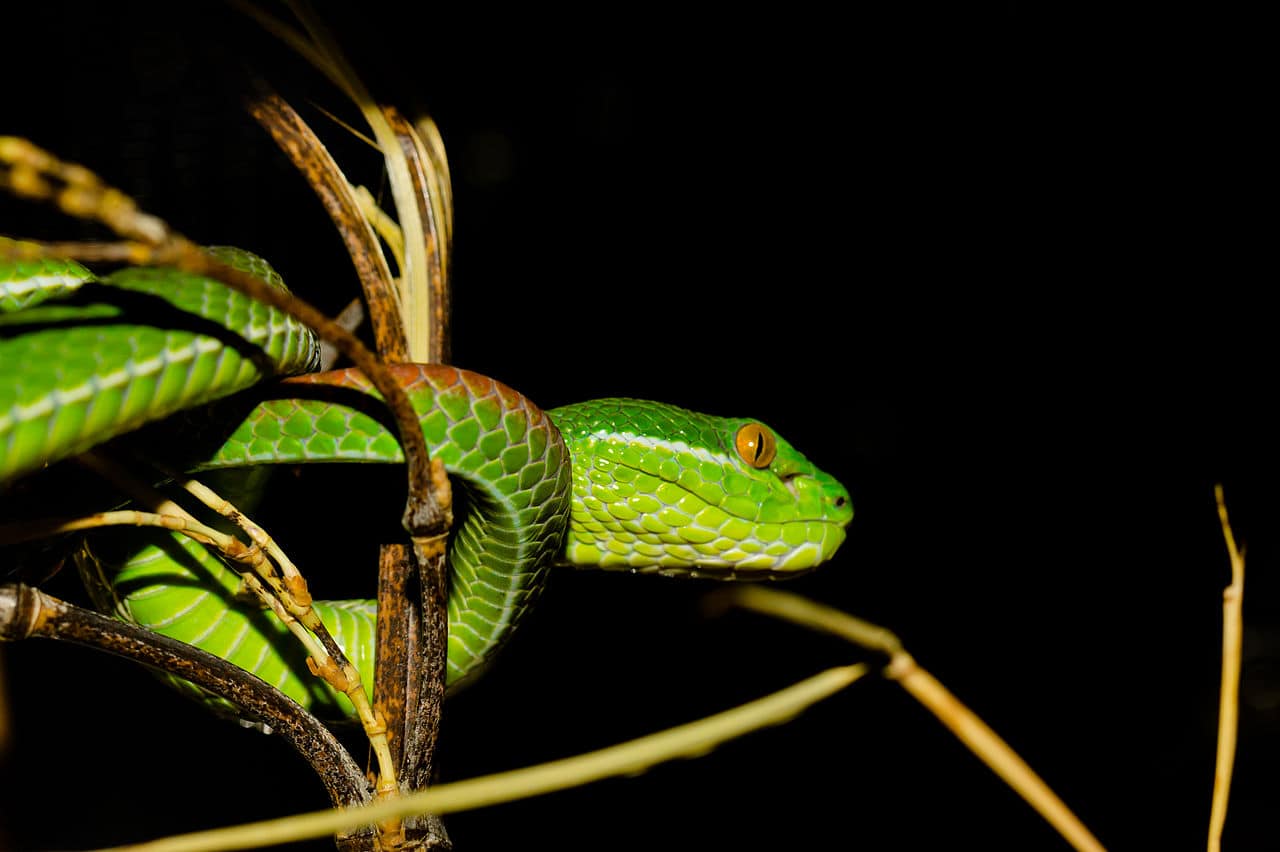
The white-lipped pitviper’s main prey is frogs, with reptiles mixed in. Their diet is still somewhat mysterious, but frogs of the Polypedates family (AKA whipping frogs) have been observed repeatedly. They completely ignore the Tokay gecko, a 30cm reptile which is the favourite prey of the golden tree snake.
A confirmed reptile prey is the oriental garden lizard, which is also eaten by Asian vine snakes. A few older reports mention rodents as prey, but a newer survey suggests that they fear them. White-lipped pitvipers were observed coiled on branches, in the Bangna district of Bangkok. When rats approached in an alleyway, sometimes chewing food as they scuttled along, the snakes withdrew into their coils. One Trimeresurus albolabris even fled its branch when the rat approached.
Despite their powers, white-lipped pitvipers are regularly eaten by the king cobra. One study followed them using radio trackers, only to find that the final destination of the signal was exactly where a king cobra was lying.
| 7 | A solitary species |
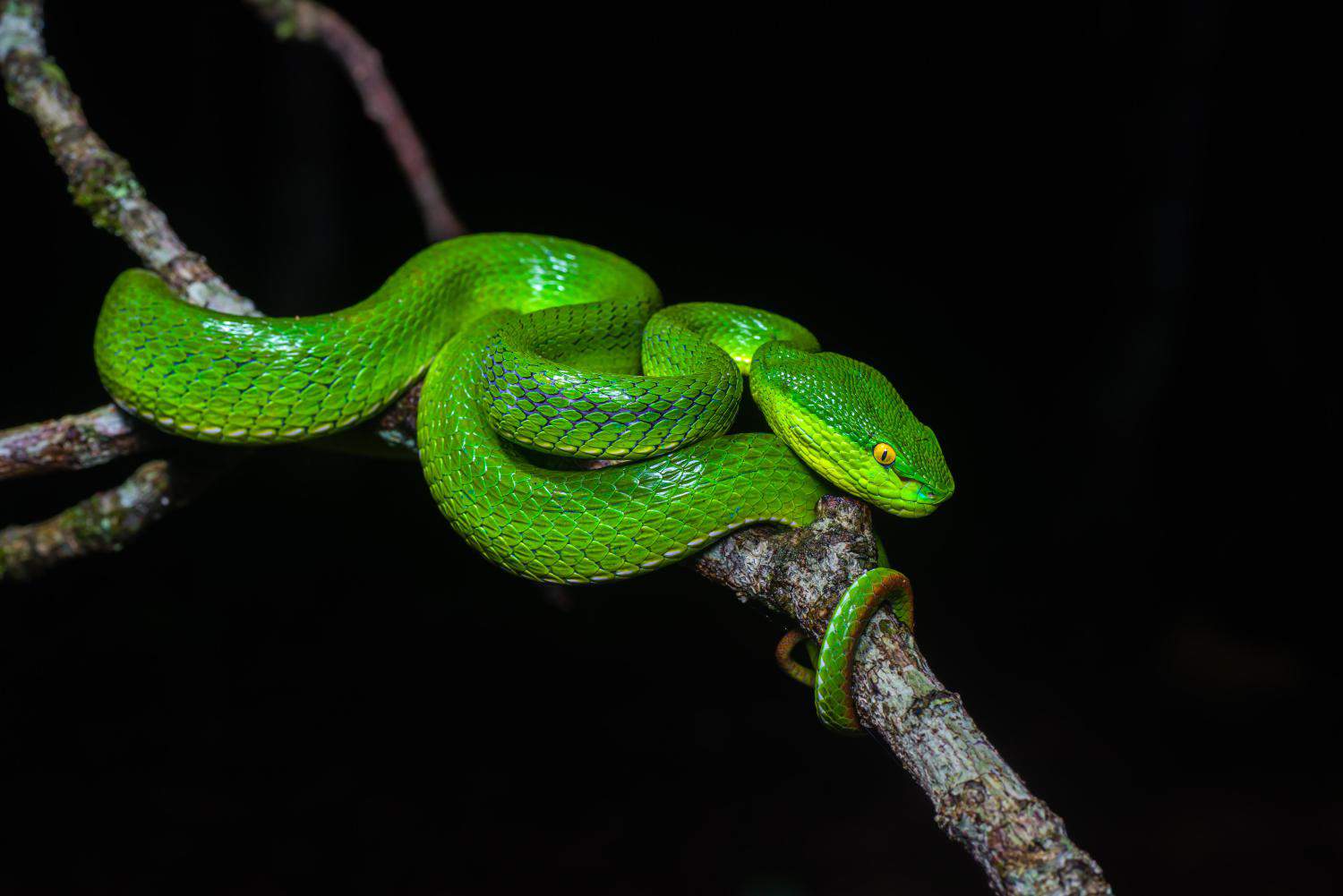
Alongside its close relative Trimeresurus macrops, the white-lipped pitviper is one of the laziest viper species in the world. A study followed 11 members of the two species in rural regions of northeast Thailand. Over 97.6 days of monitoring, their average daily movement was a mere 0.32 metres. Grand expeditions like the prairie rattlesnake (which migrate 20 miles in spring) aren’t a thing for this green-coloured snake.
The pitvipers also had very specific home ranges. None of the snakes overlapped with each other; they all had their own turf, never straying into the other, except around the very edges. In the core 50%, there was zero overlap. White-lipped pitvipers aren’t a social species; they live alone, and they hibernate alone.
Popular hibernation spots for Trimeresurus albolabris include crevices in manmade rock walls, rocks in the ground covered with leaves, and in logs. However, in the constant warmth of Thailand, this species doesn’t always bother hibernating, particularly males; they can be found in their shrubby branches all year around.
| 8 | Flashback: 1915 |
One of the oldest documented white-lipped pitviper bites happened to Malcolm Smith, which he reported in The Snakes Of Bangkok in 1915. He described a sharp throbbing pain “as if a red hot needle had been thrust into me”. This lasted for 24 hours, and was impossible to sleep through. His hand swelled like a balloon, only subsiding after one week, and a small necrotic area around the bite wound eventually sloughed off. It took 6 weeks for his hand to regain full functionality.
Fortunately, nearly all hospitals in Thailand and Hong Kong stock the cure – Thai Red Cross Society pitviper antivenin. This is made from the white-lipped pit viper specifically, with its toxins injected into animals in order to collect the immune system antibodies. Consequently, the elixir is perfectly tailored against this species’ toxin profile, while working decently but less well against close relatives like the mangrove pitviper.
Another study tested the second most popular snake antivenom in Hong Kong – Agkistrodon halys antivenom. This is made by reverse engineering the Siberian pitviper, and as you’d expect, it worked far less well against white-lipped pitvipers.
| 9 | Comparison: other green pitvipers |
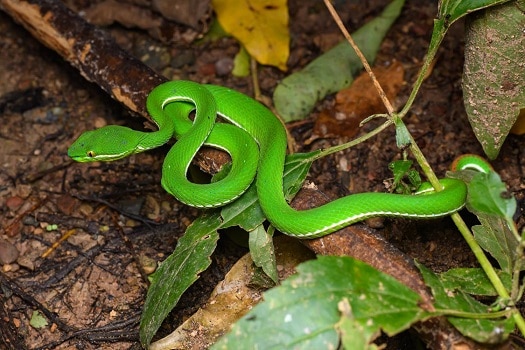
The first thing you notice with this snake is greenness, but there’s more to Trimeresurus albolabris than meets the eye. The species averages at 60-90cm, and females are larger than males. However, only males have the signature white stripe, which begins at the lip and continues along their entire body, dividing the belly and back.
Trimeresurus albolabris is mainly a rich green colour, but its belly is lighter, yellow with greenish tinges. Its chin is also lighter, while its eyes vary from orange to dark yellow.
Confusion is easy, as there’s another trimeresurus species in Thailand called the red-tailed pitviper. This has an extremely red tail, but the white-lipped pitviper also has a reddish tail, just less obviously. The species it usually coexists with is Trimeresurus macrops, and this is distinguished by its huge eyes. T. macrops also has paler yellow eyes, and its head is particularly triangular, while being smaller at approximately 70cm.
| 10 | Removed from India |
Most old descriptions of this snake talk about it living in India, but as of 2022, it is now gone from India. Not because of people fearfully slashing it with machetes, or overhunting for valuable skins, but because it was never there in the first place.
It started in 2020, when researcher Pushkar Phansalkar was exploring a trail in India’s Pakke tiger research. Suddenly, he noticed an odd green pitviper sitting on a cluster of creepers. It had a vivid orange stripe on the side of its head, and lab analysis revealed unusual numbers of teeth. It was declared to be an all new species, named Trimeresurus salazar, after Salazar Slytherin from the Harry Potter books. In 2022, several old sightings of the white-lipped pitviper were reassigned to this cunning new species.
Likewise, another new species was discovered in 2022: Trimeresurus davidi, native to India’s Nicobar islands. This too absorbed some of the old sightings. In a puff of smoke, the white-lipped pitviper was gone from India, never to return except in the loving arms of a venomous snake enthusiast. That said, it still has the largest territory of any Asian green pitviper.
